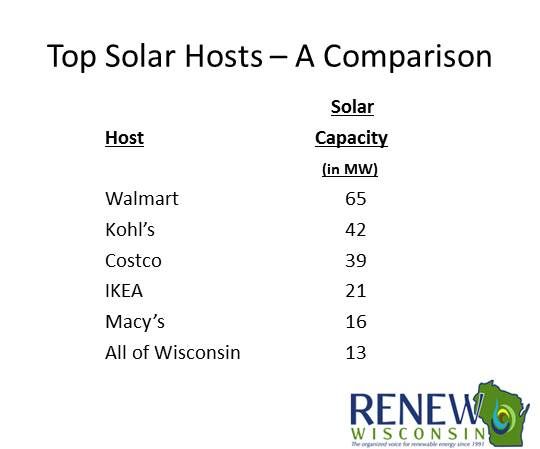Wisconsin has better sunlight than installed solar capacity world leader Germany -- but a political fight now brewing in the state could determine whether Wisconsin will use its solar potential.
“What we are trying to do with Clean Energy Choice is clarify an ambiguity in state law,” explained RENEW Wisconsin Program and Policy Director Michael Vickerman. “If we don’t clear it up, anybody who puts a system on somebody else’s house and sells the energy to the occupant is in danger of being regulated as a public utility.”
For the third-party ownership (TPO) financing model responsible for 70 percent of solar’s U.S. growth in 2012, Vickerman said, "That is a deal-breaker. Companies like Sunrun, Sun Edison and SolarCity (NASDAQ:SCTY) don’t operate in Wisconsin for that reason.”
Winter and snow reduce a Wisconsin solar system’s productivity, Vickerman acknowledged, but don’t significantly change the value proposition. “The technology has improved, especially with microinverters. The winter might cause a production loss of 10 percent to 15 percent compared to Colorado and lengthen the amortization of the system, but not a lot.”
Yet Wisconsin has been slow to grow solar. “The megawatts on Ikea stores, the megawatts on Kohl’s (NYSE:KSS) stores, the megawatts on Costco (NASDAQ:COST) stores -- all of those companies have more solar on their rooftops than the entire state of Wisconsin,” Vickerman said.

Incentives have been available for solar electric and solar hot water since 2003, Vickerman said. But that was when it looked like the state needed all the electricity it could get.
“Incentives plus individual utility initiatives from Wisconsin Electric Power (OTC:WELPP), Madison Gas and Electric (NASDAQ:MGEE), Alliant, and Wisconsin Public Service grew about three megawatts of solar,” Vickerman said. “The utilities had programs that lasted from nine months to two years that paid $0.25 per kilowatt-hour for solar in the 2008-09 period.”
Before the national economy contracted, he explained, “Wisconsin loads were growing and we needed to expand generating capacity.” Both utilities and ratepayers wanted what Vickerman called “brownie points.” Renewables advocates put through “a modest renewables standard,” he said, because “the utilities concluded that while they were adding coal and gas plants, they could make a little room for solar.” Affordable renewable energy premiums voluntarily taken on by ratepayers also helped.
Around 2010, Vickerman said, utilities pulled back. “Mainly because of the recession, they couldn’t count on load growth anymore. They had invested heavily in transmission and new fossil generation. Some new coal plants came on-line in the last six years, and the utilities felt their highest priority was to find customers for those coal-fired kilowatt-hours. Utilities have now decided solar systems are actually threats because they erode their customer base.”
In 2013, there is a maximum of $2.5 million in utility-sponsored programs available for residential systems up to four kilowatts and for business systems up to 50 kilowatts.
But solar’s value proposition in Wisconsin has changed, Vickerman said. “Solar is very popular in Wisconsin -- except with utilities. Policymakers seem blissfully unaware that the cost of solar has come down tremendously in the last two years.”
Clean Energy Choice would be a legislated clarification in state law. “For systems that are on the premises of a customer,” Vickerman explained, “the system owner could sell the energy to the customer or to the utility under an approved tariff without being considered a public utility and have everything reviewed by the Public Service Commission.”
Political action on Clean Energy Choice became necessary when Wisconsin’s Public Service Commission last year issued an informal decision validating the utilities’ interpretation of the law.
“But it’s an uphill climb. The utilities are mounting a stiff defense of the legal ambiguity,” Vickerman added. “They going to do their utmost to throttle solar.”
Clean Energy Choice is sponsored by Democratic Assemblyman Chris Taylor and Republican Assemblyman Gary Tauchen. “Unfortunately, our Republican sponsor is feeling an awful lot of pressure from the utilities right now,” Vickerman said.

Source: U.S. Solar Market Insight, Q3 2012
Unlike some Midwestern states where electricity is too cheap for solar to compete, the price of electricity is not the issue in Wisconsin.
“Our rates are close to being the highest in the Midwest.” Vickerman said. “In Madison, electricity is around $0.15 per kilowatt-hour because the small local utility is heavily invested in a share of a large coal complex, in costly transmission upgrades and in pollution control retrofits on older coal units.” Elsewhere In the state, rates are $0.13 to $0.14 per kilowatt-hour. “TPO probably could work in Wisconsin at those rates if the rule blocking it could be rectified.”
Solar has also demonstrated it can produce jobs in Wisconsin. The state has a number of active installers and is home to factories run by Spanish inverter maker Ingeteam and panel assembler Helios.
“The Clean Energy Choice legislative initiative will take time, but all the good arguments are on our side, and I think as the public becomes more familiar with solar, the utility position will weaken,” Vickerman said.
If the political initiative is stopped, Vickerman said, a legal challenge could be mounted. But he believes a political deal is possible “in which they get what they want and we get what we want.”
Wisconsin was an early regional leader in solar, Vickerman said, but currently lags behind Michigan, Illinois and Minnesota. But, he added, “considering how successful the TPO model has been at growing solar elsewhere in the country, the opportunity in Wisconsin is huge.”



